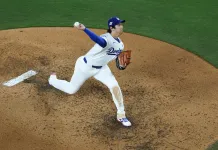Major League Baseball is going to look a lot different in 2023. A handful of rule changes are likely to have a significant impact on betting the game. At least with these – unlike the baseball, which changes from season to season – we know what they are and they are well-defined. Players got a crash course in how they would be implemented and enforced in Spring Training and the data was rather eye-opening.
The three main rule changes are the pitch clock, bigger bases and a ban on infield shifts. I’ll break these down one by one to look at the data from Spring Training and the potential impact for bettors.
Pitch Clock
– Pitchers are required to start their pitching motions within 15 seconds with nobody on base and 20 seconds with men on base
– The batter must be ready and looking at the pitcher with 8 seconds on the clock
– Pitchers are allowed two “disengagements” and batters are allowed one timeout (the number of disengagements resets if a runner advances to another base; a third disengagement is considered a balk)
– The penalty is an automatic strike or an automatic ball depending on the offending party
Rob Manfred’s biggest goal as MLB Commissioner has been to speed up the game, and these rule changes have absolutely done that. I couldn’t find a more recent tweet update, but as of March 8, Spring Training games were about 24 minutes shorter (2:37) than last season’s exhibition affairs (3:01). Regular season games averaged 3:11 last season.
From a betting standpoint, there is a lot to unpack here. Obviously, a ball or a strike in any given plate appearance is a huge deal, so those could be tremendously impactful. After a 1-0 count, MLB hitters slashed .255/.371/.428 last season. After a 0-1 count, they slashed .213/.258/.334, so even a violation to begin a plate appearance could be significant. Some of those will cancel out, as both pitchers and hitters will be guilty of infractions, especially early in the season.
The bigger one to me is actually the “disengagements” rule. Pitchers can only step off or throw over twice in a given plate appearance, which makes it really hard to hold runners. Furthermore, a baserunner can peek at the clock and time up a pitcher perfectly because the penalty is a ball and a stoppage in play anyway.
In Spring Training, we did see a major increase in stolen base attempts and about a 6% increase in successful stolen bases year over year. Last year, there were 811 caught stealings out of 3,297 attempts, so base stealers were successful 75% of the time; in Spring Training, we’ve seen an 81% success rate.
There are some caveats to this – some of the better catchers have been playing in the World Baseball Classic (WBC) or haven’t played a lot of innings, and a lot of minor leaguers with great speed who lack other tools are trying to make an impact and make a team – but, it does appear that the stolen base success rate will go up league-wide with pitchers unable to control the running game.
In theory, all teams should be more aggressive, but the teams with the most stolen bases last season were the Rangers, Marlins, Guardians, Cubs, Phillies, Diamondbacks, Royals and Yankees, who all had 102 or more. The Twins, Rockies, Tigers, Padres, Red Sox, Reds and White Sox all had 58 or fewer steals.
Catchers had 191 throwing errors last season (not all on stolen base attempts). I’d assume this number goes up with more hurried throws, so there could be some extra bases taken in that regard. Catchers will also try to throw behind runners more in hopes of keeping them close.
I’m also speculating here – and it’s hard to use the Spring Training data to confirm or debunk my theory – but I think pitch velocity will be down overall this season. Pitchers have less recovery time between pitches and may be less likely to throw with max effort. I also think the pitch clock will be a much bigger issue for relievers, who are generally slower than starters. They also throw harder on the whole.
Bigger Bases
– Bases went from 15 square inches to 18 square inches
There could be a very modest correlation between the successful stolen base rate and the bigger bases, but this was primarily a decision based on the safety of the players. The distance between first, second and third base is about 4.5 inches shorter. It is three inches shorter from home plate to first base or third base to home plate.
Home plate remains the same size.
Shift Ban
– Two infielders must be on each side of second base
– All four infielders must be on the dirt when the pitcher is on the pitching rubber
– Infielders cannot switch sides (i.e, make the third baseman play second base and the second baseman play third against a left-handed batter)
– If the infielders are not aligned at the time of the pitch, the batting team can choose an automatic ball or the result of the play
So, this is the big one and the one that has been analyzed the most by baseball scribes. It is not nearly as cut and dry as looking at last season’s batted balls to see how many hits a batter had taken away. This is going to completely change the mindset of a batter, particularly a left-handed batter who pulls the ball a lot.
On Mar. 19, @CodifyBaseball had a tweet that batting average was down one point, on-base percentage was up eight points and slugging percentage was down 18 points from the previous Spring Training. Singles were up 3% on a per-game basis, while home runs were down 14% on a per-game basis. Keep in mind, though, that a lot of elite hitters have been playing in the World Baseball Classic. (Stolen bases, by the way, were up 60% on a per-game basis)
Tom Tango, one of the most respected analysts in baseball, had a Mar. 17 tweet that the Spring Training batting average on balls in play (BABIP) was .320; from 2006-2022, the ST BABIP averaged .312, with a high of .318 and a low of .305. Spring Training comes with a grain of salt with pitchers working on things, lesser fielders, etc., but that seems to line up with the increase in singles from the other tweet. Also, home runs don’t count towards BABIP because they are not balls in play (nobody can field them), so we are seeing a big increase in balls in play and an increase in BABIP.
The tweet that really got a lot of run was from ESPN’s Jeff Passan on Mar. 9 when he noted that BABIP on ground balls was up 23 points year over year in Spring Training. It was .235 in 2022 and .258 at the time of Passan’s tweet in 2023. Another CodifyBaseball tweet on Mar. 20 noted that the BABIP for left-handed batters this spring was .329—a direct impact of the shift ban. That was up 15 points from last year. Righties saw a two-point increase in BABIP from .311 to .313.
Last regular season, the league batting average was .243 with a BABIP of .290. Left-handed batters hit .245 with a BABIP of .294. However, using Baseball Savant (Statcast) search results, lefties had a batting average of just .226 on grounders. That number will undoubtedly go up this season.
From a betting standpoint, I’m curious to see how this all plays out. Without a shift, lefties won’t shy away from pulling the ball, but they may be less likely to hit the ball in the air over the shift. The increase in singles with a decrease in home runs makes some sense based on the mindset and psychological approach for a hitter in a post-shift world. We may have more baserunners, but could ultimately end up without a big increase in offense.
MLB had a batting average problem. In the era of rising strikeout rates (though K% actually decreased for the second straight year), the last three years (.243, .244, .245 dating back to 2020) represent the lowest batting averages since the 1960s. Hitters only struck out about 16% of the time back then. Now they strike out 22-23% of the time.
In a lot of ways, we have to take something of a wait-and-see approach. Some of the best hitters have been playing in the WBC. The offensive environments in Florida and Arizona are typically conducive to offense, though it has been a little cooler than normal in AZ.
One thing we do know for sure is that teams that don’t strike out should greatly benefit from all of the new rules, so teams like the Guardians, Astros, Mets, Cardinals and Blue Jays should be helped, while teams like the Angels, Pirates, Tigers, and Marlins could be negatively impacted. In some respects, I think the rule changes absolutely make the rich richer, so to speak. They disproportionately benefit the good teams with the best hitters and the best fielders, so we could see an even more defined chasm between the haves and have-nots.
I’ll be looking for some concrete regular season data, but that will take some time. For now, I’ll handicap based on these three suspicions:
1. More stolen bases will be attempted and more attempts will be successful
2. Singles and the number of baserunners will increase
3. Fly ball pitchers won’t be as affected as ground ball pitchers and I will try to bet on more of those
It will be a learning curve for both bettors and bookmakers, but I’ll be tracking as much of the data as I can with my baseball work throughout the season – and hopefully, we can pick up on some things before the betting markets and the sportsbooks do.





